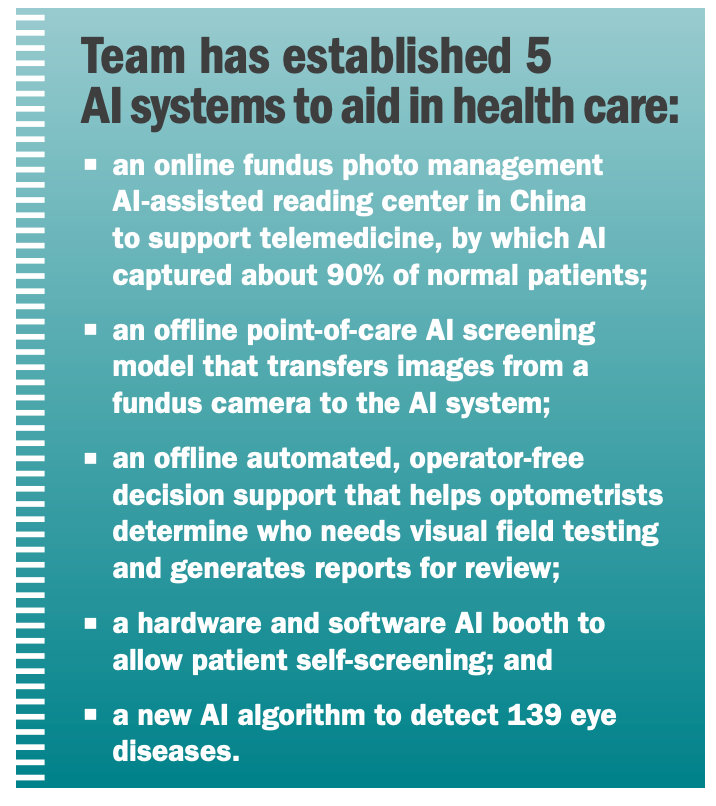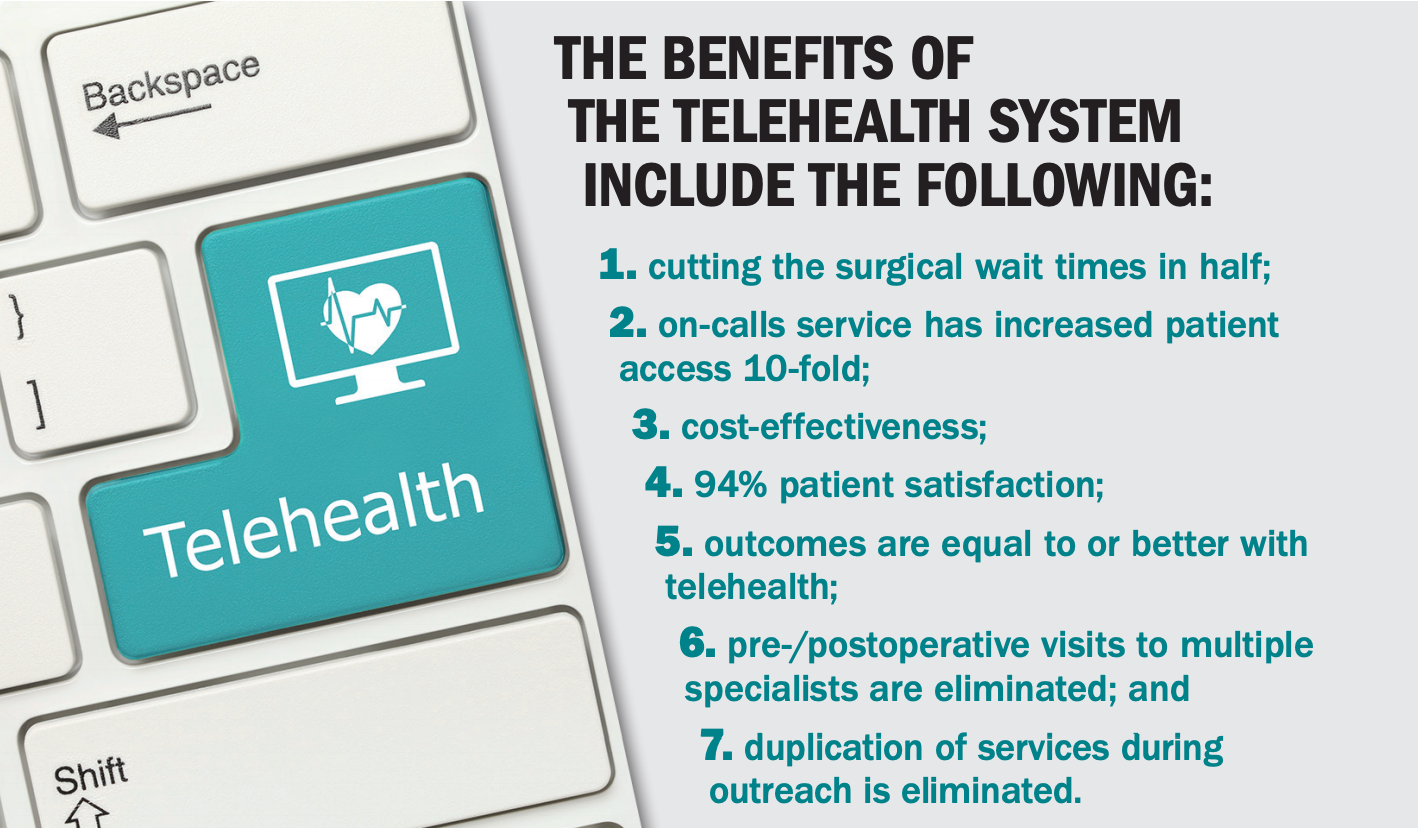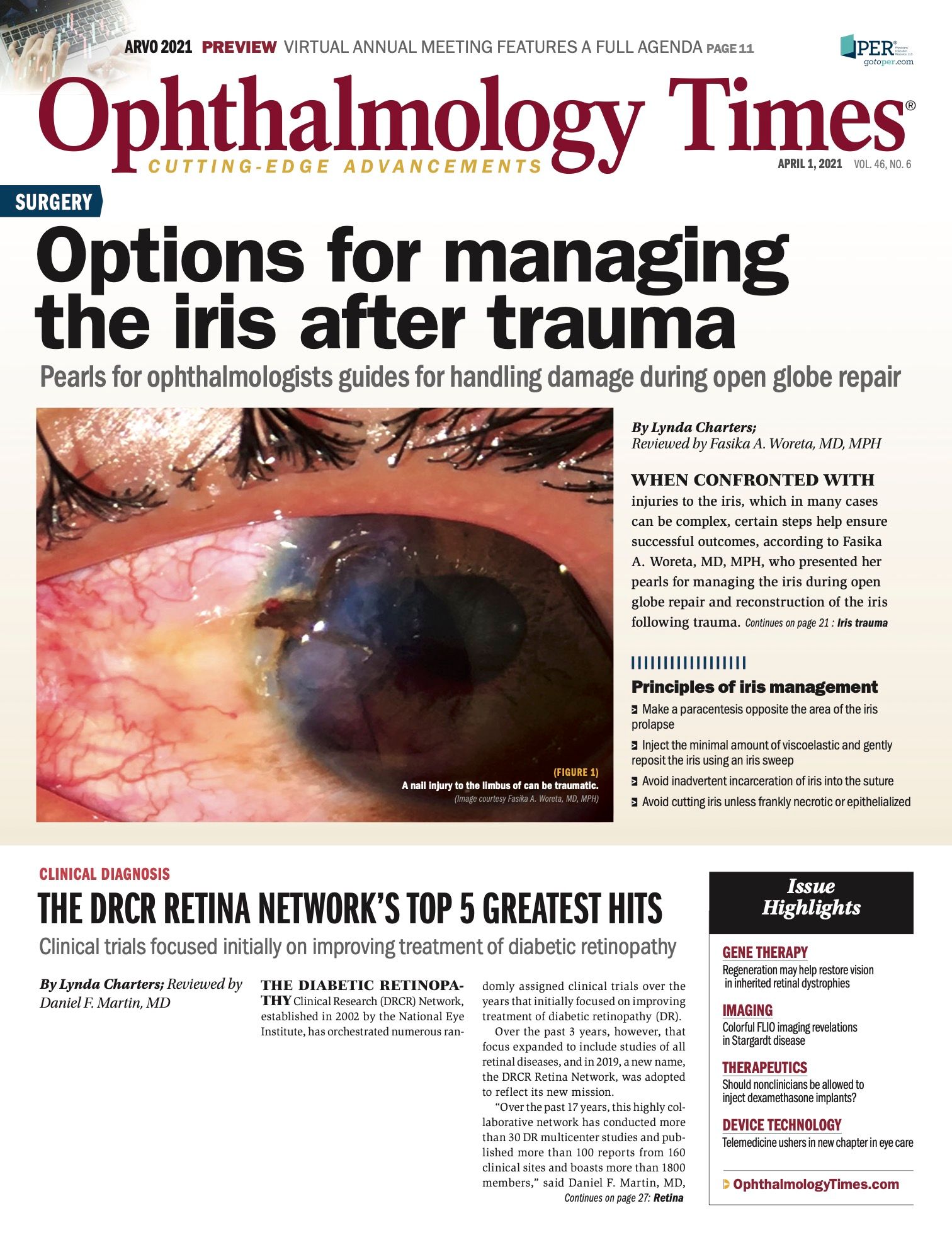Publication
Article
Digital Edition
Telemedicine ushers in new chapter in eye care
Author(s):
Worldwide increase in technologies for ophthalmic use is dramatic.


This article was reviewed by Thulasiraj Ravilla, MBA; and Angus Turner, MD
Mingguang He, MD, PhD, a professor of ophthalmic epidemiology at the University of Melbourne in Australia, described his work in deploying artificial intelligence (AI) in a telemedicine service to provide clinical care.
“Ophthalmology is a highly image-driven specialty,” he said, which lends itself to telemedicine and AI platforms.
Establishing the AI platform involved data harvesting of images and labeling diseases and their severity in the images.
Related: From ETDRS to EviRed: Eyeing a new artificial intelligence-based algorithm
He used about 70,000 images to train the neuron algorithm focusing on diabetic retinopathy (DR), age-related macular degeneration (AMD), and glaucoma.
Regarding the DR screening classification, internal data validation indicated that the accuracy of the AI algorithm was good; validation of the accuracy in multiple ethnic groups also was very good.1

The team repeated this work for glaucoma classification2 and achieved excellent accuracy, and very good accuracy for AMD.3
A heat map study4 of deep-learning technology proved that AI can accurately classify diseases based on similar features used by clinicians.
They then established websites to which clinicians could upload clinical images with diagnosed diseases to see how well AI did in identifying them.
“Most studies reported robust accuracy of the AI classification. Many require real-world validation,” He explained. “The current project targets 4 major diseases and many are trying to create more algorithms to make the diagnosis more accurate or include more diseases. Another area of interest is making an automated care model. Deploying AI in the real world in medicine is challenging and involves more than the neural network, such as many medicolegal issues and patient and doctor interactions.”
Related: Emerging therapies in management of AMD
New models of care
Gavin Tan, MD, associate professor at Duke-NUS Medical School, Singapore National Eye Center, Singapore, created a new model of care that integrates the 3 elements for DR screening.
“In ophthalmology, this has been enabled by our embrace of multimodal digital imaging; that is, fundus and slit-lamp imaging and optical coherence tomography, all of which can be delivered remotely to facilitate decision making,” he said.
Tan and his team combined teleophthalmology, AI, and standard fundus cameras to evolve from the traditional print/slide media to digital media in this patient population.
As he described, the DR diagnosis does not require additional clinical data, the technology provides robust outcomes and cost-effectiveness, and there was less resistance to change by ophthalmologists.
In addition, the AI training was easy because of the extensive available clinical data.
Related: 5 ways the DRCR Retina Network is reshaping diabetic eye disease
The Singapore Integrated DR Program, the bones of which are image capture sites, transmission to a reading center for grading, and reports sent to primary care physicians, covers 150,000 diabetic patients.
All the data collected were the basis for the AI program, which was seen to make its decisions based on findings similar to those seen as clinicians, he explained, with accuracy of 93.6%.5
The AI program then was integrated into their clinical screening system. The primary grading system is being replaced with the AI linear system (SELENA).
The images are still graded by human evaluators for patients who are being referred for care to maintain the highest sensitivity and specificity but concurrently reduce the workload substantially.
In addition to screening, 2-way video consults, 1-way virtual clinics by which physicians can review notes and future management is implemented if needed, and home-monitoring devices used by patients to cut travel time and make appointments as needed.
Related: The value of new diagnostics and personalized medicine
Tan’s group has also established a virtual clinic to monitor stable retinal disease that blossomed as the result of COVID-19.
Patients are classified as having high-intensity active disease requiring monthly treatment or stable disease, the latter representing from 30% to 50% of the population.
This allows history taking, visual acuity (VA) measurements, and imaging remotely followed by review by technicians and by physicians for management if needed.
The AI system in many cases can be better than physicians in identifying peripheral pathologies such as proliferative DR. The imaging clinics can be combined with video consultations as Tan did with the glaucoma service at the Singapore National Eye Center.
Looking forward, he and his colleagues are starting trials of patients measuring their own VA using mobile applications. They also have started home-monitoring applications that do not require patients to travel for evaluation.
An application called Alleye (Oculocare Medical Inc.) is a pilot home-monitoring device that lets patients determine whether the VA has deteriorated asymptomatically, facilitating early recognition of recurrent disease.
Related: Developing retinal technologies strengthen visualization
Alleye was tested in about 700 patients with several diseases.
Over 6 months, 33 patients had triggers, 7 of which were significant and 5 had disease progression.
“Digital technology can transform eye care. Telehealth and AI are highly connected, synergistic technology platforms. Teleophthalmology is successful in screening for DR. AI in ophthalmology shows good performance for specific tasks. Real-world application requires further development and integration. Mobile devices and home monitoring have long-term potential in future eye care,” he concluded.

India: Telemedicine to service millions
Thulasiraj Ravilla, MBA, director of operations for Aravind Eye Care System (AECS) in Madurai, India, described how he and his team used telemedicine to provide eye care to millions of Indian patients.
“Eye care services tend to be urban-centric; our challenge was to bridge the divide to reach patients everywhere,” he said.
AECS opted to use telemedicine to provide universal primary eye care. Ravilla developed a 4-pronged approach to achieve this: focus on community need, comprehensive and quality eye examinations, closing the care loop to ensure appropriate intervention, and remote management.
Related: Integrating AI to manage DR in a primary care setting
“We see 3 roles for technology: support the caregiving process, manage all associated processes from finance to human resources, and monitor the entire process,” he said.
AECS first built an electronic medical record (EMR) in the cloud for simultaneous collaboration between ophthalmologists and the remote vision technician in rural vision centers.
All patient information, including history and investigations, is entered live into the EMR.
This information, combined with real-time conversation with the technician and patient through telemedicine link, facilitated the diagnosis and generating appropriate prescription for spectacles or medicines.
“This technology supported design, closes the care loop within the local setting, and thus enables better adherence by the patients,” he said.
The vision centers also use AI in the system; a retinal image is uploaded into the cloud and a reading is generated in seconds, giving the severity of the diabetic retinopathy. This technology, as it evolves, can also be used to monitor chronic disease progression.
Related: Deep learning algorithm proven accurate for AMD classification
Ravilla estimated that the network of 79 vision centers covers 6.9 million people. In addition, AECS also has a mobile screening van with a RetCam Shuttle (Clarity Medical Systems, Inc.) to screen for retinopathy of prematurity; using custom-built software, the images are uploaded to the base hospital for review.
“Technology is emerging as a great enabler and makes it possible for millions of people to get good eye care locally. However, the technology needs to be robust, reliable, simple to learn and use, and inexpensive to make financial sense in rural remote settings, where the scale is low,” he emphasized.
Western Australia: Accessing remote indigenous communities
Western Australia has a sparse population spread over vast distances, with some patients traveling 10 hours to obtain surgical services, said Angus Turner, MD, of the Lions Institute in Perth, Australia.
He explained and emphasized the challenge accessing these individuals who have as everyone elsewhere but with higher prevalence rates because of the gaps in services.
The traditional service had patients traveling hours to reach a specialist for a diagnosis of a cataract, for example, then returning home and waiting 1 to 2 years for a cataract procedure.
Related: Teleretinal screening fails to do double duty for detecting glaucoma, cataracts
Eliminating the preoperative and postoperative visits in this scenario was key to patients obtaining the needed services.
Optometry and ophthalmology work hand-in-hand in Western Australia. The optometry service is extensive in the Aboriginal population and visits the primary care settings.
“This is key to our telehealth service. The optometrists perform the evaluations and provide the intimate knowledge about what I need to do surgically or what is required to manage individual patients,” he said.
Telehealth in Australia has focused on diabetic retinal screening for decades and more recently introduced real-time video consultations.
A mobile van service provides specialist outreach services, and the examination equipment is carted from place to place to facilitate those services.
The video consultations began in 2011 as a result of the Medicare Initiative, and optometry was included in 2015. The system allows the optometrist at one end to evaluate the patient with the video running and the specialist viewing it at the other end.
Related: AI algorithms: a work in progress
The initial barriers to the consultation were not technology and cost, but rather the availability of an on-call specialist, the scheduling of 2 health professionals and the patient in a room at the same time, and the alignment of the EMR and the images, he explained.
COVID-19 presented a complication with travel restrictions imposed. Resident optometrists set up clinics in hospitals and used the dormant equipment.
Telephone interviews, especially for blind patients, were used more. As a result, consultations during 2020 increased by 47% with telehealth.
--
Mingguang He, MD, PhD
e:mingguang@unimelb.edu.au
This article was adapted from the telehealth presentations during the eyeRISE 2021 virtual symposium. He has no financial interest in this subject matter.
Thulasiraj Ravilla, MBA
e:thulsi@aravind.org
Ravilla has no financial interest in this subject matter.
Angus Turner, MD
e:angus.turner@uwa.edu.au
Turner has no financial interest in this subject matter.
Gavin Tan, MD
e:gmstansw@nus.edu.sg
Tan has no financial interest in this subject matter.
--
References
1. Li Z, Keel S, Liu C, et al. An automated grading system for detection of vision-threatening referable diabetic retinopathy on the basis of color fundus photographs. Diabetes Care. 2018;41(12):2509-2516. doi:10.2337/dc18-0147
2. Li Z, He Y, Keel S, Meng W, Chang RT, He M. Efficacy of a deep learning system for detecting glaucomatous optic neuropathy based on color fundus photographs. Ophthalmology. 2018;125(8): 1199-1206. doi:10.1016/j.ophtha.2018.01.023
3. Keel S, et al. CEO 2019; Development and automation of a deep-learning algorithm for the detection of neovascular AMD from color fundus photographs. Clin Exp Ophthalmol. 2019 doi.org/10.1111.ceo.13575
4. Keel S, Wu J, Lee PY, Scheetz J, He M. Visualizing deep learning models for the detection of referable diabetic retinopathy and glaucoma. JAMA Ophthalmol. 2019;137(3):288-292. doi:10.1001/jamaophthalmol.2018.6035
5. Ting DSW, Cheung CYL, Lim G, et al. Development and validation of a deep learning system for diabetic retinopathy and related eye diseases using retinal images from multiethnic populations with diabetes. JAMA. 2017;318(22):2211-2223. doi:10.1001/jama.2017.18152

Newsletter
Don’t miss out—get Ophthalmology Times updates on the latest clinical advancements and expert interviews, straight to your inbox.




